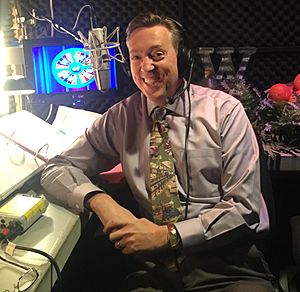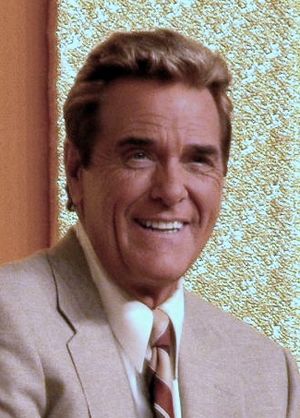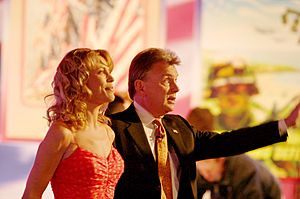Wheel of Fortune (US game show) facts for kids
Wheel of Fortune is a popular game show on television. It was created by Merv Griffin in 1975. The show first aired during the day from 1975 to 1982. It has been on in the evenings since 1983. Pat Sajak has been the main host since 1981. Vanna White joined as the letter-turner in 1982. The show is now in its 41st season, starting in September 2023.
Contents
How Wheel of Fortune Works
Three players compete in this game. It's like a mix of the game hangman and a spinning prize wheel. Players guess letters to solve word puzzles.
Starting the Game: Toss-Up Puzzles
The game begins with a $1,000 Toss-Up puzzle. Letters appear one by one on the puzzle board. Players can buzz in to solve the puzzle before all letters are shown. If a player guesses wrong, they cannot try again for that puzzle.
Since September 2019, there are also Triple Toss-Up puzzles. These are three puzzles in a row, all in the same category. Each is worth $2,000. The third Triple Toss-Up puzzle decides who starts the fourth main round.
Spinning the Wheel: What Can You Land On?
The big wheel has 24 spaces. When a player lands on a cash space, they earn that amount. This amount is multiplied by how many times their chosen letter appears in the puzzle. For example, if you land on $500 and guess 'S', and there are three 'S's, you earn $1,500!
Players can buy a vowel (A, E, I, O, U) for $250.
Special Wedges and Prizes
The wheel also has special spaces:
- Lose a Turn: You lose your turn, but you keep any money you've earned in that round.
- Bankrupt: You lose all the money and prizes you've earned in that round. You also lose your turn.
- Free Spin: If you land here and guess a correct letter, you earn a "Free Spin" token. This token lets you spin again if you land on "Bankrupt" or "Lose a Turn."
- Wild Card: This card lets you call for an extra consonant later in the game. You can use it in the bonus round too!
- 1/2 Car Tags: There are two of these. If you win a round with both tags, you win a new car! Each tag is also worth $500 per letter.
- Prize Wedge: This is a special prize announced before the round. To win it, you must land on the wedge, call a correct letter, and solve the puzzle without hitting "Bankrupt."
- Gift Tag: This is a $1,000 credit to spend at a specific company. It also gives you $500 per letter.
- $1,000,000 Wedge: In the first three rounds, you can try for this. If you get it and make it to the bonus round, you could win $1,000,000!
- Free Play: This is a safe space! You can do anything without risk. You can buy a vowel for free, even if you have no money. If you guess a wrong letter, you don't lose your turn. A consonant on "Free Play" is worth $500.
Different Rounds of Play
The value of the top dollar space on the wheel changes:
- Round 1: $2,500
- Rounds 2 and 3: $3,500
- Round 4 and later: $5,000
In Round 2, two "Mystery Wedges" are added. One hides $10,000, and the other hides a "Bankrupt." If you land on one, you can either take $1,000 per letter or flip the wedge over. If you find the $10,000, you win it only if you solve the puzzle without hitting "Bankrupt."
Round 3 is the "Prize Puzzle" round. The player who solves this puzzle wins a special prize, often a trip! This round also has an "Express Wedge." If you land on it and guess a correct letter, you can keep playing normally. Or, you can choose to play for $1,000 per letter without spinning. But be careful! If you guess a wrong letter or take too long, it counts as a "Bankrupt."
When time is running out in a round, a bell rings. The host spins the wheel one last time. All remaining consonants are worth $1,000 plus the value the host landed on. Vowels are free. The player in control then has three seconds to solve the puzzle.
The Final Challenge: Bonus Round
The player with the most money at the end of the game goes to the bonus round. If there's a tie, they play one more Toss-Up puzzle to decide.
In the bonus round, the player picks one of three categories. They spin a smaller bonus wheel, which has 24 prize envelopes. A new puzzle is shown. The player is given the letters R, S, T, L, N, and E for free. Then, they choose three more consonants and one vowel. If they have a "Wild Card," they can pick a fourth consonant.
They then have 10 seconds to solve the puzzle. If they solve it, they win the prize in the envelope they landed on. Prizes can be cash amounts from $35,000 to $50,000, a car with $5,000 cash, or even $100,000! If the player brought the "Million Dollar Wedge" to the bonus round, the $100,000 prize is replaced with $1,000,000!
Meet the Hosts
Over the years, Wheel of Fortune has had several hosts and announcers.
Chuck Woolery was the first host of Wheel of Fortune. He hosted the show from 1975 until 1981.
Pat Sajak has been the main host since 1981. Vanna White joined him in 1982 as the famous letter-turner. They have been a team for the evening show since 1983.

The show also has an announcer who introduces the players and describes prizes. Jim Thornton has been the announcer since 2011.
Images for kids
See also
 In Spanish: Wheel of Fortune para niños
In Spanish: Wheel of Fortune para niños





